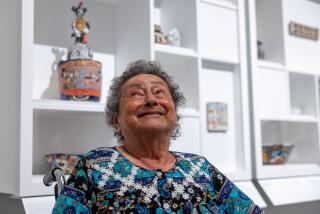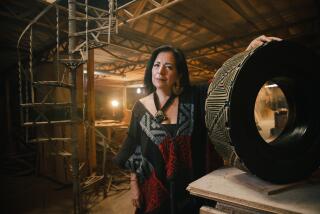Mother, daughters, memories
- Share via
The past is prologue, and so are blood and race. Growing up, artist Lezley Saar felt the pull of polarized identities: a mother of African American, Irish and Native American ancestry; a father with German, English and Scot forebears. Her art, she acknowledges, tends to the autobiographical. “Me, Myself and Identity Crisis,” her 1998 painting made inside a cutout book, shows two sisters joined at the hip -- one white, one black -- floating over a forlorn beach. Adrift, they wear matching red jumpers and white blouses. One holds a toy; the other reads a book.
“It’s a strange, freaky image, these conjoined twins,” says Saar, 53, “but I wanted it to be pretty and ethereal at the same time.”
Using art to tackle themes personal and public is something Saar learned from her mother, Betye Saar, 79, and shares with her sister, Alison Saar, 50. The work of all three and their dramatic use of media -- painting, sculpture and assemblage -- is showcased in “Family Legacies: The Art of Betye, Lezley, and Alison Saar,” at the Pasadena Museum of California Art through Aug. 27. With 45 works from four decades, “Legacies” represents the first time the three have been in a major show together. Shared themes are threaded throughout, not only racial identity and politics but the enduring power of family and of myth.
Separate sensibilities are also apparent. “Thematically we follow along the same lines,” says Alison, who, like her sister, has come to the museum as the show is being installed. “Coming from the same environment, we’ve had similar experiences, but how diversely those experiences can be interpreted, how varied those directions can be -- seeing the works side by side, you can see the differences.”
The paintings and collage works of Betye and Lezley hang on taupe-colored walls; Alison’s sculptures dot the open space. Near the entrance is Alison’s “Inheritance,” in which a girl figure covered in a “skin” of patterned ceiling tin stands balancing a huge ball made of wound cotton cloth. The artist says it refers to the family burden her mother had to bear as a girl, as well as to that of children in Africa, hoisting aloft their heavy bundles and even siblings.
Farther back is a figure of a black woman hung by her ankles, her glittering gold hair cascading several feet to the floor. “Blonde Dreams” refers to fairy tales, Alison says, and to the price women pay for trying to be beautiful to the measurement of others.
The exhibition grew out of a doctoral dissertation that art historian Jessica Dallow was writing on Betye and Alison Saar at the University of North Carolina at Chapel Hill. She learned that Lezley also was an artist, and “once I found out more about the family connection, it morphed into a larger project,” Dallow says. In 2000, with the encouragement of Barbara Matilsky, curator of exhibitions at the university’s Ackland Art Museum, Dallow wrote a proposal for a show encompassing the work of all three.
“The work is so powerful,” says Matilsky, who co-curated with Dallow. “They all incorporate found objects but in such unique ways, and they deal with such important social issues.”
It took five years for the exhibition to get off the ground -- work had to be borrowed from about 20 museums, galleries and private collectors, as well as the artists. It opened at Ackland in December; Pasadena is its second stop before it travels to the San Jose Museum of Art.
For Betye Saar, having the show in Southern California is a homecoming. She was brought up in Pasadena and attended Pasadena Community College before heading to UCLA. “We lived there with my great-aunt,” she recalls, speaking by telephone from her Laurel Canyon studio. “And when she died in 1974 she left me this trunk full of things, things she had brought from the Midwest, small bits of jewelry, old gloves and handkerchiefs.”
Betye, as the daughters like to say, is “the pathfinder.” She started as a printmaker but after seeing a show of Joseph Cornell’s boxes at the Pasadena Art Museum (now the Norton Simon Museum) in 1967, she became intrigued by the narrative possibilities of assemblage. “They were very jewel-like,” she says. “It was like putting a whole little world in a small container.” With her young daughters in tow, she scouted flea markets, thrift shops and estate sales to pick up old photographs, accessories and household items, and began putting together her own miniature tableaux. Sometimes she integrated items passed down from family, such as the ones in that trunk.
One enduring concern has been exploring and exploding stereotypes. Her signature piece, “The Liberation of Aunt Jemima” (1972), is set in a glass-front box and features an Aunt Jemima figurine with a broom in one hand, a rifle in the other. “I take the image and recycle it,” Betye explains. “Instead of making her a slave, a domestic who’s looked down upon and ridiculed, I’m making her a warrior.” That piece is now in Paris at the Centre Pompidou’s “Los Angeles 1955-1985” exhibition, which continues through July 17.
Betye picked up the motif again for a 1998 show at her New York gallery, Michael Rosenfeld, called “Workers + Warriors: The Return of Aunt Jemima.” From that series, the Pasadena show includes “Supreme Quality,” in which a washboard is adorned with the front and back of a gun-toting Aunt Jemima figure standing over the words, “Extreme times call for extreme heroines.”
Does Aunt Jemima, invented in 1893 as part of a pancake advertising campaign, still have relevance today? “Do we still have racism?” Saar shoots back. “That’s just a symbol of racism, a graphic image, but racism is still here.”
While growing up, Lezley and Alison apprenticed with their father, Richard Saar, a ceramicist and art conservator. Even so, each was drawn to another career. Alison trained as an art historian, but “then I realized I wanted to make things.” Lezley worked in community radio, but began to make paintings on altered books.
“I’ve often said that Alison is the sculptor, Lezley is the painter, and I’m the object maker,” Betye explains.
Lezley prefers to concentrate on one series of work at a time. She created a number of pieces -- including installations, paintings and even dishware -- for “Mulatto Nation,” which she showed at Jan Baum Gallery in L.A. in 2003. In establishing her “nation,” she painted portraits of its founding mothers and fathers, including “Elizabeth Keckley: Mrs. Lincoln’s Seamstress.” Inspired by a photograph of the historical Keckley, who worked for the first lady, Lezley painted the figure on fabric printed with a birdhouse motif. Fragments of embroidery and quilting run along the lower part of the banner shape. On the front of Keckley’s prim dress is a fist forming the letter M in sign language -- a reference to mulatto power, Lezley says -- and she holds a melting snowball in her left hand.
“The whole questioning of identity is pretty tongue-in-cheek here,” the artist adds. “At the time I painted this, I was doing a residency in Aspen, so I threw a snowball in.”
“I’ve done a lot of research in world mythologies and how they overlap and coincide,” Alison says. “I’ve been especially interested in the perseverance of African deities in the Americas, and despite efforts to erase them, how they survive in rituals and symbols.”
One of these deities is the “mother of the waters,” known as Yemeja in Brazil and the centerpiece of Alison’s installation “Afro Di(e)ty.” Here Yemeja is a powerful woman bathing in cold water, with a silver fan in one hand and a bolt of blue cloth emanating from the other. Her hair is made of twists of coral, and behind her is a kind of celestial map with stars represented by seashells.
“Legacies” ends with a collaborative salute to Richard Saar, who died last year. Lezley created a large banner covered with round cutouts of found photographs -- she calls them “floating memory cells” -- connected by a network of nodules drawn on paper. Alison fashioned 81 giant teardrops out of cast bronze to flank the banner, as well as the ravens that hold it up. “Eighty-one for how old he was when he died,” she says.
Betye’s contribution is an assemblage of stopped clocks and a framed portrait of the next generation -- her six grandchildren. Lezley and Alison, as well as youngest sister Tracye Saar-Cavanaugh, have two children each.
Like their other work, the installation unapologetically touches on the emotional and spiritual.
“It’s different from other art out there, it deals with feelings,” says Betye. Too many artists today, she says, are interested only in making money, in making a product. “When Lezley and Alison referred to me as a pathfinder, maybe that’s something I taught them -- that art has to mean something to them.”
*
‘Family Legacies: The Art of Betye, Lezley, and Alison Saar’
Where: Pasadena Museum of California Art, 490 E. Union St., Pasadena
When: Noon to 5 p.m. Wednesdays through Sundays
Ends: Aug. 27
Price: $6; seniors and students, $4
Contact: (626) 568-3665; www.pmcaonline.org
More to Read
The biggest entertainment stories
Get our big stories about Hollywood, film, television, music, arts, culture and more right in your inbox as soon as they publish.
You may occasionally receive promotional content from the Los Angeles Times.










